General Information
Biotin Labeling Kit - SH is primarily used for the preparation of biotin-labeled IgG for enzyme immunoassay (EIA). SH-Reactive Biotin, a component of this kit, has a maleimide group that reacts with sulfhydryl group (SH) of reduced IgG or other macromolecules. This kit contains all of the necessary reagents for the labeling. Reducing Agent in this kit creates free sulfhydryl groups in the IgG molecule without loss of antibody affinity. The labeling process is simple. After the reducing reaction, add SH-Reactive Biotin to IgG solution on the filter membrane, and incubate at 37°C for 30 min. On the average, 1 to 2 biotin molecules conjugate to each reduced IgG. Excess biotin molecules can be removed using a Filtration Tube included in this kit.
Kit Contents
| SH-Reactive Biotin | 3 tubes |
| WS Buffer | 4 ml x 1 |
| Filtraion Tube | 3 tubes |
| Reducing Agent | 3 tubes |
| Reaction Buffer | 1 ml x 1 |
Capacity
Three samples labeling
- Sample requirement: Protein (Molecular weight > 50,000; amount: 50-200 µg)
Storage Condition
Store at 0-5°C. This kit is stable for 1 year at 0-5°C before opening.
|
Caution SH-Reactive Biotin After a SH-Reactive Biotin is taken out from the seal bag, keep the unused SH-Reactive Biotin(s) in the bag, seal tightly and store at -20°C. Store the other components at 0-5°C. |
Required Equipment
- 10 µl, 200 µl adjustable pipettes
- Incubator (37°C)
- Microtubes
- Microcentrifuge
- DMSO
Precaution
- If the target protein solution contains other proteins with molecular weight larger than 10,000 purify the protein solution and use the purified target protein for biotin labeling.
- If the protein solution contains small insoluble materials, centrifuge the solution and use the supernatant for the labeling.
- The amount of Reducing Agent is optimized for the preparation of the reduced IgG. Please examine the necessary amount of Reducing Agent for the reduction of other proteins.
- The droplets which induced from the dry inhibitor of membrane, are occasionally found inside Filtration Tube while storing the kit at 0-5°C or after returning to room temperature. This phenomenon does not affect the performance.
General Protocol
-
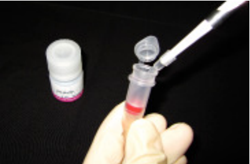
Step 1.
Add 100 µl WS Buffer and the sample solution containing 50-200 µg proteina) to a Filtration Tube.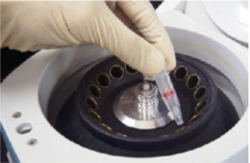
Step 2.
Centrifuge at 8,000 × g for 10 min.b)
-
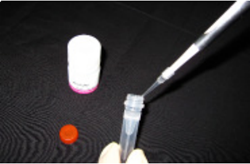
Step 3.
Add 150 µl WS Buffer to a tube of Reducing Agent,c) and dissolve with pipetting.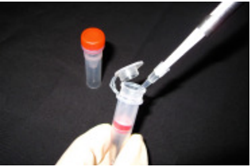
Step 4.
Transfer 100 µl of the Reducing Agent solution onto the membrane of Filtration Tube, and pipette to dissolve the protein on the membrane.
-
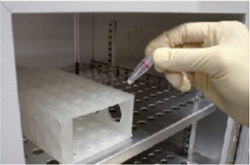
Step 5.
Incubate the tube at 37°C for 30 min. Add 100 µl Reaction Buffer, and centrifuge at 8,000 × g for 10 min.b)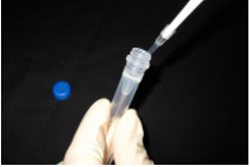
Step 6.
Add 10 µl DMSO to SH-Reactive Biotin, and dissolve it with pipetting.d)
-
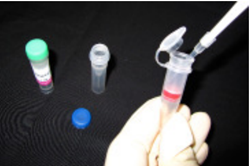
Step 7.
Add 100 µl Reaction Buffer and 8 µle) SH-Reactive Biotin solution to the Filtration Tube, and pipette to mix.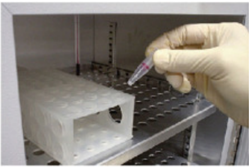
Step 8.
Incubate the tube at 37°C for 30 min. Add 100 µl WS Buffer to the Filtration Tube, and centrifuge at 8,000 × g for 10 min.b)
-
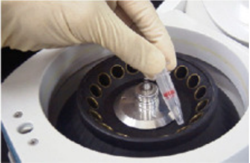
Step 9.
Add 200 µl WS Buffer, and centrifuge at 8,000 × g for 10 min.b) Repeat this step.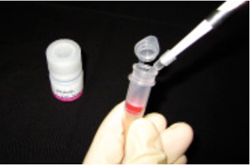
Step 10.
Add 200 µl WS Buffer, and pipette about 10 times to recover the conjugate.f) Transfer the solution to a 0.5 ml tube (not included in this kit), and store at 0-5°C.
a) The volume of protein solution should be less than 100 µl. If the protein concentration is lower than 0.5 mg/ml, repeat Steps 1 and 2 until the total protein accumulation becomes 50-200 µg.
b) If solution still remains on the filter after the centrifugation, spin for another 5 min.
c) The reagent may be attached to the inner wall of the cap. Please open the cap carefully.
d) SH-Reactive Biotin is on the bottom of the tube. Add 10 µl DMSO to the bottom of the tube, and pipette several times to dissolve. SH-Reactive Biotin is unstable in DMSO. Proceed to Step 7 immediately after the preparation of the SH-Reactive Biotin solution.
e) If the amount of protein is 200 µg, add entire SH-Reactive Biotin solution.
f) Since we recommend using WS Buffer to recover biotin-conjugated protein, you can choose any kind of buffers appropriate for your experiment.
Biotin Labeling Reaction

* Disulfides that are not in the hinge region may be reduced.
Q & A
Can I use this kit to label antibody which is commercially available?
Yes. However, if antibody solution contains other proteins such as serum albumin or gelatin, labeling reaction might be interfered by that protein. Purification of the antibody solution with affinity chromatography is necessary prior to use this kit. Contact us for the purification procedure, if you need.
Which protein can be labeled with Biotin using this kit?
It can be possible to label protein that the molecular weight is over 50,000 with reactive SH groups.
How long is the biotin-labeled protein stable?
Stability of conjugate depends on the protein itself. In the case of labeling for rabbit IgG, the labeled IgG is stable at 4°C for 2 months. However, for longer storage, add equal volume of glycerol to the sample solution and store at -20°C.
How many biotin molecules are introduced to protein?
The number of conjugated biotin depends on the protein. In the case of rabbit IgG, 1 to 2 biotin molecules conjugate to each reduced IgG.
What is the minimum amount of protein that can be labeled using this kit?
We recommend using 50 ~ 200 µg as a minimum amount. Though 10 µg protein can be labeled using this kit, the background will increase.
Can I use this kit to label oligonucleotides or oligopeptides?
No. Oligonucleotides and oligopeptides may be too small to retain on the membrane filter of the Filtration Tube.
In immunoassays such as ELISA and Western blots , what should I do to reduce the background?
In order to reduce the background increase, add a blocking process or use a blocking reagent as a diluent of the biotin-labeled protein.
Is there any notice for treatment of living cells with the Biotin-labeled protein?
We recommend using PBS including 2-10% FBS for preparation of cell suspension to maintain the best cell conditions.
Does recovery buffer (WS Buffer) have harmful effect to living cells?
No. WS Buffer contains stabilizing agent (surfactant) that is controlled of its concentration without cytotoxicity. If you are concerned about the additive in WS Buffer, you can use your own buffer currently used instead of WS Buffer.
Frequently Asked Questions / Reference
LK10: Biotin Labeling Kit - SH
Revised Nov., 21, 2023


 Hidden sections will not be printed.
Hidden sections will not be printed.